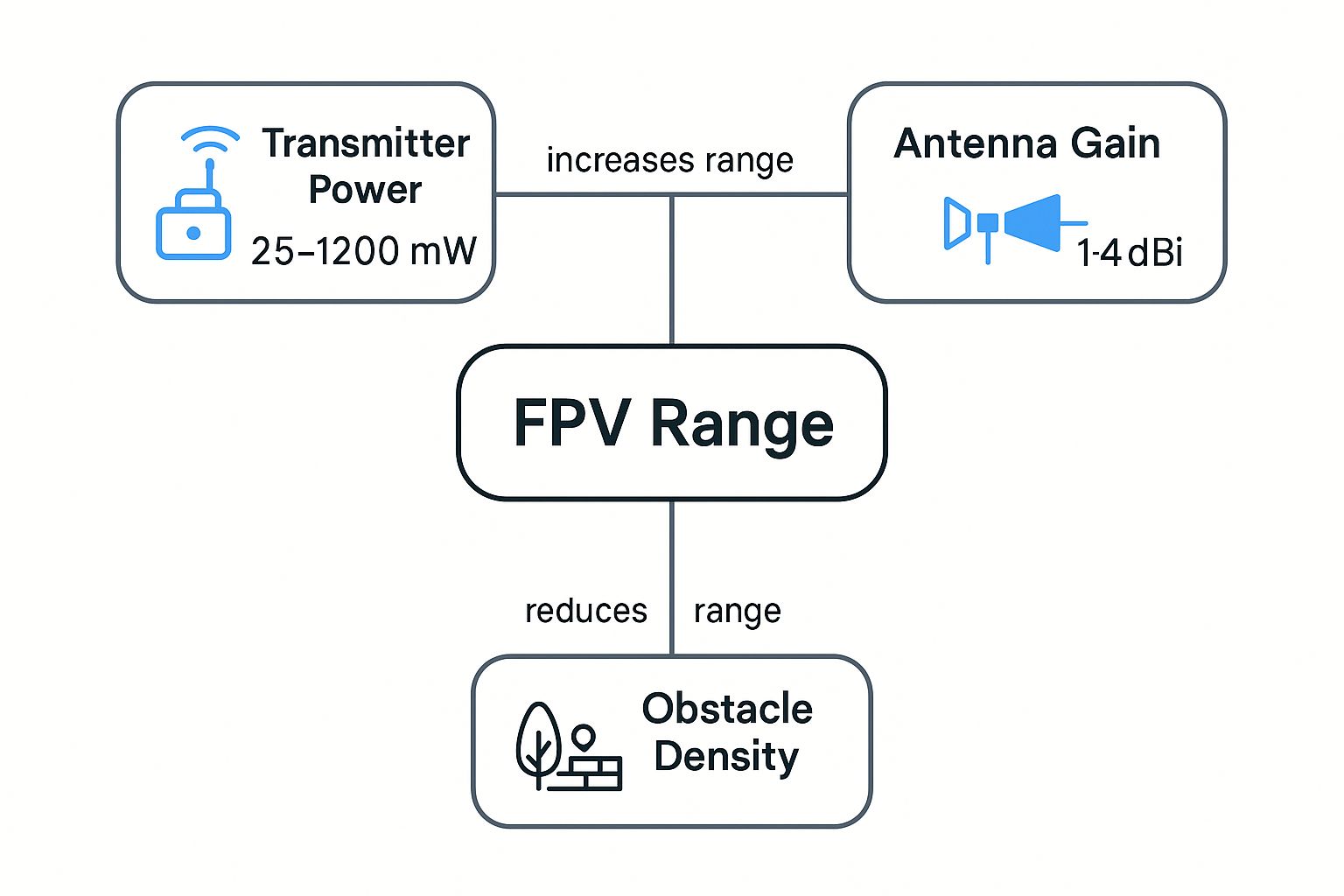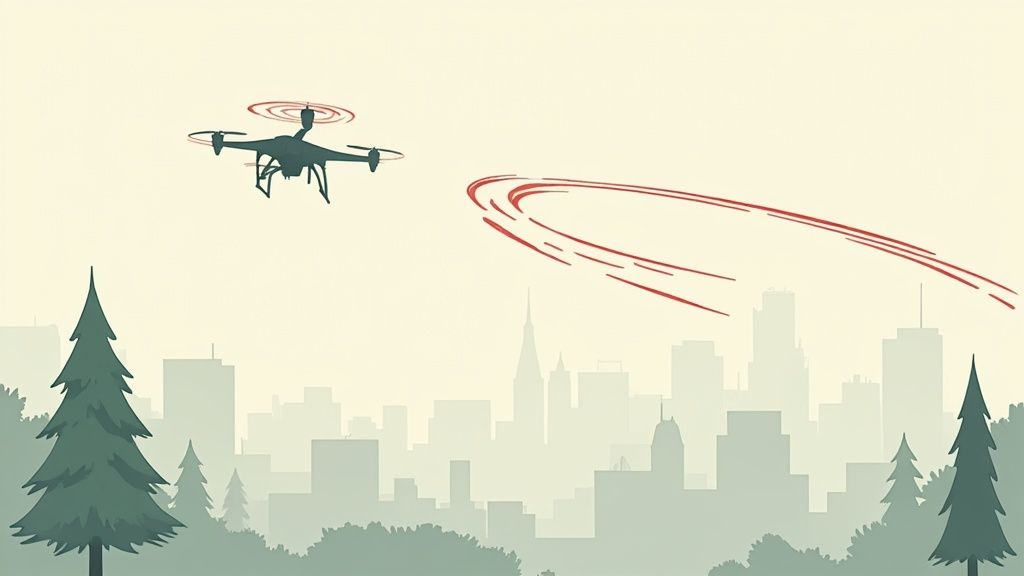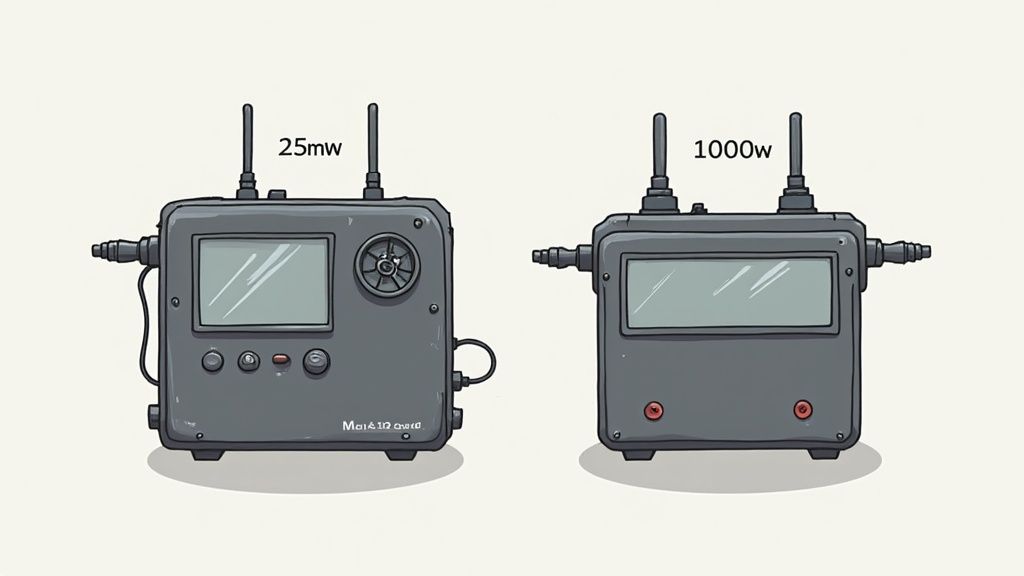Mastering Drone FPV Range
- Paul Simmons

- Jul 7
- 13 min read
When you're starting out, a good rule of thumb is that a typical hobbyist FPV drone can fly between 1 to 5 kilometers (that’s about 0.6 to 3 miles). But with specialized long-range gear, some pilots are pushing that out to 10 kilometers and even further.
The real trick is understanding that your maximum range isn't a fixed number. It’s a dynamic dance between your drone's power, your antenna setup, and whatever's in the air between you and your quad.
What Determines Your FPV Drone Range
Ever had your FPV feed turn to static just as you were about to nail that perfect dive or explore a cool new spot? It’s a classic FPV moment, and it all comes down to the two signals keeping you in the air.
Think of it like having two separate conversations with your drone at the same time. One is for control, and the other is for video. Getting a handle on how these two signals work is the key to flying safer and pushing your limits without losing your drone.
Understanding Your Drone's Two Signals
Your drone is constantly communicating with your gear on two different channels. One tells it where to go, and the other shows you what it sees. While they work together, they have very different jobs and, more importantly, different weaknesses.
The big takeaway here is that your video signal is almost always the first to go. It has to send a ton more data than the control link, making it the weakest link in the chain. Even if you have a rock-solid control signal, you're flying blind if you can't see anything. That’s your effective range limit.
Key Factors Influencing Signal Strength
So, what actually makes those signals stronger or weaker? It really boils down to three main things that you have some control over.

As you can see, getting the best possible range is a balancing act. You need enough transmitter power, efficient antennas, and a clear line of sight to your drone.
This constant push for better performance is exactly why the FPV drone market is exploding. It's projected to jump from USD 139.3 million in 2024 to over USD 562 million by 2032, all driven by pilots and manufacturers chasing more power, clarity, and flight time.
Key Takeaway: Your video signal (VTX) is your lifeline. The moment you see it start to break up, it's time to turn around. Don't wait for your controls to fail—by then it's often too late. Mastering this one rule is the foundation of safe long-range FPV.
This limitation is the driving force behind so much innovation in the FPV world. While we often focus on battery life, engineers are exploring all sorts of ways to extend flight times and capabilities. For a glimpse into the future, check out our piece on how hydrogen fuel cell drones promise longer flights with zero emissions.
The Core Technology That Defines FPV Range

To really get a feel for drone FPV range, you need to peek under the hood at the three core parts of its communication system. Picture yourself standing on one side of a huge field, talking to your drone on the other with a set of walkie-talkies. How far that conversation can reach depends on a few key pieces of gear working together flawlessly.
The first piece of the puzzle is transmitter power, which is basically how loudly you're speaking into your walkie-talkie. In the FPV world, this is handled by your Video Transmitter, or VTx. Its power output, measured in milliwatts (mW), has a direct and immediate impact on your signal strength.
For example, a typical racing drone might be limited to a 25mW VTx to meet event regulations, giving you just enough range to cover a small track. But if you swap that out for a long-range VTx capable of pushing 800mW or even a massive 1.6W (1600mW), you're essentially shouting. That signal "volume" lets it travel much farther before it starts to fade out.
Receiver Sensitivity And Antenna Performance
Next up is receiver sensitivity. Think of this as how well your goggles can hear the drone’s signal. If your VTx is shouting, your receiver needs a good set of ears to pick up the message clearly, especially when it’s far away. A high-quality receiver is excellent at pulling a faint signal out of the background noise, which translates to a clearer picture right at the edge of your range.
Finally, we have antenna performance. Your antennas are like megaphones for both the transmitter and receiver—they don't create new power, but they focus the existing power in a specific way. This focus, or gain, is measured in decibels isotropic (dBi).
You'll mainly come across two types:
Omnidirectional Antennas: These are your classic "lollipop" or "pagoda" style antennas. They send and receive signals in a 360-degree donut shape, which is perfect for freestyle flying where your drone is constantly changing its orientation relative to you.
Directional Antennas: This group includes patch and Yagi antennas that you mount directly on your goggles. They concentrate the signal into a tight, narrow beam, kind of like a spotlight. You sacrifice coverage to your sides and behind you, but this focused beam can massively boost your drone FPV range in whichever direction you're facing.
By combining a powerful VTx with a sensitive receiver and the right antennas, pilots can create a robust link capable of miles-long flights. For instance, pairing a 1.6W VTx with a high-gain directional patch antenna is a common strategy for pilots aiming to break the 5km range barrier and beyond.
Understanding how these three components play off each other is everything. A weak VTx can't be completely fixed by a great antenna, and a powerful VTx is worthless if your receiver is "deaf" to its signal. True long-range performance is all about optimizing the entire system, making sure every part works in harmony to give you a stable, clear connection so you can fly with confidence.
How Frequencies and Protocols Shape Your Signal

When it comes to your drone FPV range, not all radio waves are created equal. Getting a grip on how they behave is the first real step to flying farther and more reliably. The frequency you use for your control and video links has a massive impact on how far that signal can punch out and how well it gets through obstacles.
Think of it like sound. A low frequency, like 900MHz, is the deep, booming bass from a huge concert speaker. Its long, powerful waves travel incredible distances and have a much easier time passing through things like trees or even thin walls. This is exactly why it’s a go-to choice for pilots who need a rock-solid control link for long-range missions.
On the flip side, a high frequency like 5.8GHz—the standard for most FPV video feeds—is more like a high-pitched whistle. Its short, zippy wavelengths are great at carrying a ton of data, which gives you that crisp, clear video. But they get stopped dead by solid objects and fizzle out much faster over distance.
The Penetration Power of Frequencies
This difference in behavior is why your video feed can turn to static behind a thicket of trees while your control link doesn't even flinch. The higher-frequency video signal just doesn’t have the muscle to push through the way the lower-frequency control signal does.
This isn't a new concept; it’s been a core principle of FPV since the beginning. Back in the late 1990s and early 2000s, pioneers were already using low-frequency 900MHz systems to hit ranges of around 3 miles (about 4.8 kilometers). They knew lower frequencies were the ticket to pushing those boundaries, sometimes adding special antennas to squeeze out another mile. You can dive deeper into these early FPV achievements and their historical context.
Key Insight: For maximum range and reliability, especially when obstacles are in play, a lower frequency is almost always the winner. That’s why so many long-range pilots pair a 5.8GHz video system with a 900MHz or 2.4GHz control link—you get the best of both worlds.
How Digital Protocols Changed the Game
While picking the right frequency is huge, modern digital FPV systems have added a whole new layer to the performance equation. Systems from DJI, Walksnail, and HDZero don't just blindly transmit a signal; they actively manage it.
Imagine an analog signal as a raw, unfiltered conversation. As you move farther apart, the voice gets fainter and more crackly until it's just noise. A digital signal, though, is like having a super-smart translator working between you and the drone.
Error Correction: Digital systems spot and fix minor data losses on the fly, smoothing out glitches before you even notice them.
Frequency Hopping: They intelligently jump between different channels within their band to sidestep interference, always seeking the clearest path for communication.
This is precisely why a digital video feed often looks perfect right up until the moment it drops completely. Instead of a slow, painful descent into static, you get a crystal-clear image for much longer. This advanced signal processing gives digital systems a massive leg up in maintaining a quality link, delivering a clean experience in situations where analog would be pure mush.
Identifying Common Environmental Range Killers

Sometimes, the biggest threat to your FPV range has absolutely nothing to do with your gear. You could have the most powerful transmitter and the best antennas money can buy, but if the environment is actively working against you, your signal is going to suffer. Learning to read these invisible forces is what separates a good flight from a great one.
The most obvious problem is physical obstruction. It helps to think of your video signal as a beam of light. Anything that gets between you and your drone—a thicket of trees, a concrete building, or even a big hill—will block or weaken that beam. This is exactly why maintaining a clear line of sight (LOS) is so vital for pushing your range limits.
Even flying behind a single, large tree can be enough to turn a crystal-clear video feed into a screen full of static. Water is also surprisingly good at absorbing radio waves, so flying low over a large lake can sometimes cut your range more than you'd think.
The Problem of Radio Frequency Noise
Beyond solid objects, you have to deal with Radio Frequency (RF) interference. Picture this: you're trying to have a quiet conversation in the middle of a loud, crowded party. Even if you're speaking clearly, the person you're talking to will struggle to hear you over all the background chatter. Your drone's signal faces the exact same challenge.
This "noise" comes from all sorts of sources broadcasting on or near the same frequencies your FPV system uses, especially the popular 5.8GHz band.
Common sources of RF interference include:
Cell Phone Towers: These are incredibly powerful transmitters that can easily drown out your video receiver.
Wi-Fi Routers: In urban or suburban areas, the air is just saturated with Wi-Fi signals, creating a very noisy RF environment.
High-Voltage Power Lines: The electromagnetic fields thrown off by major power lines can also play havoc with your signal.
A spot that looks visually perfect, like a wide-open field next to a shopping center, might actually be an RF nightmare. The sheer number of Wi-Fi networks and cellular activity can cripple your effective FPV range before you even hit a physical obstacle.
This is why your drone can perform so differently from one location to another. A flight out in a remote, rural valley with clear line of sight will almost always give you better range than flying in a city park surrounded by buildings and wireless signals. Learning to scout locations for both physical and RF "quiet" is a skill that truly levels up your piloting.
Practical Steps to Maximize Your FPV Range
Alright, you understand the theory. Now, let's get into the good stuff—the practical, real-world steps you can take to push your drone FPV range further, safer, and more effectively. This is your action plan for getting farther down that trail or higher up the mountain. We'll start with the simplest changes that give you the biggest bang for your buck.
Think of your FPV signal as a fragile conversation in a crowded room. Your first job is to give it the clearest, most direct path possible. Launching from a high point, like the top of a hill, is one of the most powerful things you can do, and it doesn't cost a dime. It immediately lifts you above all the ground-level noise and obstacles that soak up your signal.
Just that one change can be a complete game-changer, giving you a rock-solid connection right from the start.
Prioritize Your Antennas
Before you even dream about a more powerful VTx, you need to look at your antennas. I can't stress this enough: an excellent antenna setup on a lower-power VTx will almost always punch out farther than a sloppy antenna setup on a high-power one. It's about working smarter, not just harder.
Proper Placement: Make sure your drone's VTx antenna has a clear line of sight, especially to the rear. The carbon fiber frame and the big LiPo battery are signal killers. A slightly longer antenna mount that holds the active part of the antenna above the battery can make a night-and-day difference.
Goggle Upgrades: Your goggle antennas are the other half of the equation. For long-range, the gold standard is a mix of an omnidirectional antenna (like a "lollipop") and a high-gain directional antenna (like a patch or helical). This gives you great coverage when you're flying nearby and a focused beam to "punch out" when you're flying straight away from yourself.
A common rookie mistake is to focus only on what the drone is transmitting. Your FPV system is a two-way street. Your goggles need to be able to "hear" just as well as the drone can "shout." Honestly, upgrading to a quality patch antenna is often the single biggest hardware improvement a pilot can make for long-range.
Smart Component Selection and Setup
With your antennas sorted, you can start looking at the hardware itself. For long-range builds, your choice of components really starts to matter. Many pilots move to larger 7-inch or even 10-inch frames because they're more efficient and stable when you're cruising for long distances.
Of course, a powerful Video Transmitter (VTx) is a popular upgrade. Jumping from a standard 200mW VTx to one that can push 1.6W (1600mW) gives your signal a massive power boost, letting it travel much farther before it starts to break up. Just remember, more power creates more heat and chews through your battery faster.
Finally, for any serious long-range flight, a GPS module is non-negotiable. It's what makes Betaflight's "GPS Rescue" mode work—a lifesaver feature that automatically flies your quad back home if you lose your video or control link.
Before you ever attempt a long-range flight, you have to be disciplined about your safety checks. For a full rundown of what to inspect, take a look at our drone pre-flight checklist with essential safety tips. This simple habit can be the difference between an amazing flight and a long, sad walk. Your drone FPV range depends just as much on reliability as it does on raw power.
Navigating The Legal and Safety Limits of FPV Flying
It’s one thing to push your gear to its technical limits, but it’s another thing entirely to know where the legal lines are drawn. This is what separates a responsible pilot from a reckless one. The simple truth is that the maximum drone FPV range your quad can technically achieve is often way beyond the distance you’re legally allowed to fly it. Understanding this distinction is the bedrock of safe and smart FPV operation.
In most places, including the United States under FAA regulations, the number one rule is maintaining Visual Line of Sight (VLOS). What does that mean? It means you, the pilot, have to be able to see your drone with your own unaided eyes at all times. If you lose sight of it, you're flying illegally and, more importantly, unsafely.
This isn't some new rule cooked up for FPV. The need for direct operational control goes way back. Drones have a long history, evolving from military tools like the Boeing BQ-7 in WWII into the amazing recreational and professional machines we fly today, and the regulations have grown right alongside them. You can dive deeper into the long history of drone development and its influence on modern flight rules to see how we got here.
Staying Within The Rules
So, how do you even attempt long-range flight while respecting VLOS? The answer is teamwork. You need a visual observer, often called a spotter. This person becomes your eyes in the sky, maintaining constant, unaided visual contact with the drone while communicating everything they see back to you, the pilot in command.
Beyond just seeing the drone, there are other rules to follow. Regulations often dictate a maximum transmitter power output, which directly caps your potential range. Flying with an illegally powerful video transmitter isn't just a simple violation; it risks interfering with other critical radio services that people depend on.
Important: This information is for educational purposes and is not legal advice. You must always check the specific drone laws in your country and local area before you fly. Claiming you didn't know the rules won't save you from serious penalties.
For pilots in the US thinking about turning their FPV skills into a business, there’s another layer of certification required. It's worth looking into why you might need a Part 107 license to fly commercially and understanding the responsibilities that come with it. True mastery of long-range FPV isn't just about skill—it's about flying with respect, knowledge, and a deep commitment to safety for everyone.
Common Questions About Drone FPV Range
Once you start getting serious about FPV, a few questions about drone FPV range always seem to surface. Let's dig into some of the most common ones to clear up any confusion and help you make smarter choices with your equipment.
Will a More Expensive Drone Automatically Have Better Range?
Not always. While it's true that high-end, ready-to-fly drones often pack quality components, their design is a balancing act of many different features, not just raw range. A custom-built drone, specifically put together for long-distance flying with the right antennas and video transmitter, can easily fly farther than a more expensive, all-purpose quadcopter.
Price doesn't directly translate to distance. The real difference-makers are the specific FPV system you're using and how well it's set up.
Is Digital or Analog FPV Better for Long Range?
You can push the limits with both systems, but they act very differently as you approach the edge of their range.
A high-quality analog system with a powerful VTx can fly for miles, but you'll watch the picture slowly dissolve into static the farther you go. Digital systems, on the other hand, deliver a perfectly crisp image right up until the signal abruptly cuts out entirely.
If your only goal is pure, maximum distance, a carefully tuned analog setup is tough to top. But for a dependable and clear picture throughout your flight, many pilots prefer the experience digital provides.
Can I Legally Fly Beyond My Visual Line of Sight?
For most recreational pilots, flying Beyond Visual Line of Sight (BVLOS) is against the law. In the U.S., for example, the FAA requires that either you or a dedicated spotter maintain direct, unaided visual contact with the drone at all times. You need a specific waiver to do otherwise.
Stretching your drone’s range is a huge part of the fun, but it's essential to fly responsibly and within legal boundaries. Protecting your gear and flying legally are two sides of the same coin; learn more in our guide on how to protect your investment with drone insurance.
At JAB Drone, we're committed to helping you fly farther and safer. Explore our expert guides and reviews to get the most out of every flight. Visit us at https://www.jabdrone.com.




Comments